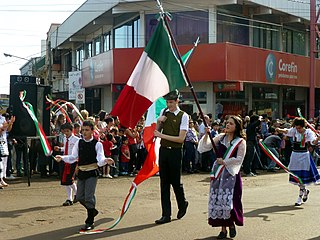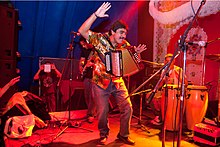
Sinaloa, officially the Estado Libre y Soberano de Sinaloa, is one of the 31 states which, along with Mexico City, comprise the Federal Entities of Mexico. It is divided into 18 municipalities and its capital city is Culiacán Rosales.

Tamaulipas, officially the Free and Sovereign State of Tamaulipas, is a state in Mexico; one of the 31 states which, along with Mexico City, comprise the 32 Federal Entities of Mexico. It is divided into 43 municipalities.
Asian Latin Americans are Latin Americans of Asian descent. Asian immigrants to Latin America have largely been from East Asia or West Asia. Historically, Asians in Latin America have a centuries-long history in the region, starting with Filipinos in the 16th century. The peak of Asian immigration occurred in the 19th and 20th centuries. There are currently more than four million Asian Latin Americans, nearly 1% of Latin America's population. Chinese, Japanese, and Lebanese are the largest Asian ancestries; other major ethnic groups include Filipinos, Syrians, Indians, and Koreans. Brazil is home to the largest population of East Asian descent, estimated at 2.08 million. The country is also home to a large percentage of West Asian descendants. With as much as 5% of their population having some degree of Chinese ancestry, Peru and Mexico have the highest ratio of any country for East Asian descent. Though the most recent official census, which relied on self-identification, gave a much lower percentage.
Márquez or Marquez is a surname of Spanish origin, meaning "son of Marcos or Marcus". Its Portuguese equivalent is Marques.
Latin American Canadians are Canadians who are descendants of people from countries of Latin America. The majority of Latin American Canadians are multilingual, primarily speaking Spanish, Portuguese, French and English. Most are fluent in one or both of Canada's two official languages, English and French. Spanish and Portuguese are Romance languages and share similarities in morphology and syntax with French.

Italian Mexicans are Mexican-born citizens who are fully or partially of Italian descent, whose ancestors were Italians who emigrated to Mexico during the Italian diaspora, or Italian-born people in Mexico. The ancestors of most Mexicans of Italian descent arrived in the country during the late 19th century. Their descendants have generally assimilated into mainstream Mexican society.

Italian Venezuelans are Venezuelan-born citizens who are fully or partially of Italian descent, whose ancestors were Italians who emigrated to Venezuela during the Italian diaspora, or Italian-born people in Venezuela. Italians were among the largest groups of European immigrants to settle in the country. Approximately 5 million Venezuelans have some degree of Italian ancestry, corresponding to about 16% of the total population of Venezuela, while there were around 30,000 Italian citizens in Venezuela.

Italian Argentines are Argentine-born citizens who are fully or partially of Italian descent, whose ancestors were Italians who emigrated to Argentina during the Italian diaspora, or Italian-born people in Argentina.

A French Chilean is a Chilean citizen of full or partial French ancestry. Between 1840 and 1940, 20,000 to 25,000 French people immigrated to Chile. The country received the fourth largest number of French immigrants to South America after Argentina (239,000), Brazil (150,341) and Uruguay.

French Mexicans are Mexican citizens of full or partial French ancestry. French nationals make up the second largest European immigrant group in Mexico, after Spaniards.
The African diaspora in the Americas refers to the people born in the Americas with partial, predominant, or complete sub-Saharan African ancestry. Many are descendants of persons enslaved in Africa and transferred to the Americas by Europeans, then forced to work mostly in European-owned mines and plantations, between the sixteenth and nineteenth centuries. Significant groups have been established in the United States, in Latin America, in Canada, and in the Caribbean (Afro-Caribbean).

There is a significant Argentine diaspora in Mexico. According to the 2010 census, there were 13,696 registered Argentine citizens living in Mexico, an increase from the 6,465 registered in the 2000 census. Argentine immigrants constitute the second largest community of South Americans in Mexico and the fifth largest immigrant community overall.

There is a small Chilean diaspora in Mexico. According to the 2010 census, there were 5267 registered Chilean citizens living in Mexico, an increase from the 3,848 registered in the 2000 census. Chilean immigrants constitute the fifth largest community of South Americans in Mexico and the fifteenth largest immigrant community overall.

Britons in Mexico, or British Mexicans, are Mexicans of British descent or British-born persons who have become naturalized citizens of Mexico.

Venezuelan Mexicans are Mexicans who trace their heritage, or part of their heritage, to the nation of Venezuela. As of 2015, Venezuelans were the fifth largest immigrant group in Mexico, following Americans, Guatemalans, Spaniards and Colombians. By 2020, the Venezuelan population became the third largest immigrant group.

Italian Colombians are Colombian-born citizens who are fully or partially of Italian descent, whose ancestors were Italians who emigrated to Colombia during the Italian diaspora, or Italian-born people in Colombia. Italians have been immigrating to Colombia since the early 16th century.

Harry Geithner Cuesta, known as Harry Geithner, is a Colombian actor, film director and producer known for being CEO of Geithnerland productions Inc., a production company, talent agency and content creator audiovisuals for film, theater, television and social networks located in New York City; where, in addition, acting classes, voice education, performing arts and accent neutralization are taught. One of his sisters is Aura Cristina Geithner, a prominent actress and singer.

Herrera is a surname of Spanish origin, from the Latin word ferrāria, meaning "iron mine" or "iron works" and also the feminine of Latin ferrārius, "of or pertaining to iron"; or, alternatively, the feminine of Spanish herrero, which also gives the surname Herrero. Variants of the name include Errera, Ferrera and the less common Bherrera. Its equivalent in Portuguese and Galician is Ferreira. Also, because of Spanish naming customs, some people are listed here with their family name as their second-to-last name.

Colombian Argentines are Argentine citizens of partial or full Colombian descent, or Colombian citizens who have migrated to and settled in Argentina. As of 2014, there were 87,574 Colombians living in Argentina, most of whom migrated during the 2010s.

















